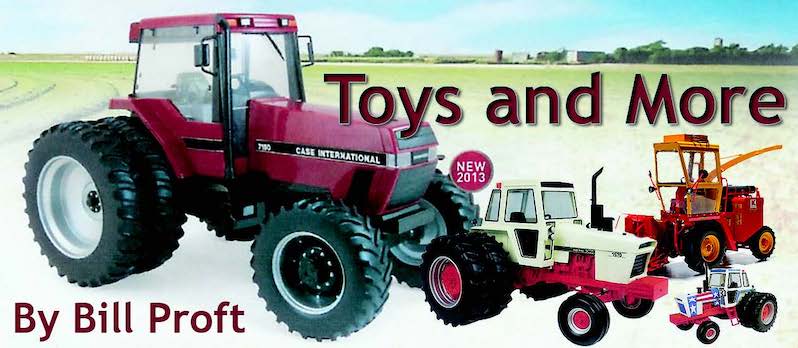In this issue of Classic Farm and Tractor, I am going to cover some of the early New Holland farm toys produced by Ertl. But first, I wanted to share a unique pedal tractor with you that I saw at the National Farm Toy Show last November. Photos 1 and 2 provide left and right side views of a custom Allis-Chalmers Two-Twenty pedal tractor. At least two dealers had these at the show. Each has a special plate mounted on the left side of the frame just ahead and above the pedal. The plate indicates that the tractor was made in Hokes Bluff, AL in 2017 and also provides the “serial number.” Apparently only 12 were produced and the plate will say “1 of 12” or “5 of 12,” etc. These are really neat pedal tractors with tons of added detail, especially in the engine area. Filters, fuel lines and even a fan are included. It also appeared as though the headlights actually work as well. I did not inquire about the price, but I am confident it was quite high. This would be a unique item for those of you who collect Allis-Chalmers tractors and equipment.
So, let’s get started with some of the Ertl New Holland toys from the late 1960s. I’m not exactly sure why, but I have always liked New Holland farm equipment from that time when the company was not partnered with Ford. We had a New Holland Super Hayliner 69 baler on the farm along with a hay conditioner and at least one manure spreader. All of these machines worked very well and I guess that I was somewhat enamored with the red and yellow paint scheme. Ertl started producing New Holland toys in 1968 which are highly sought after today based on the current prices. However, we will discuss prices later.
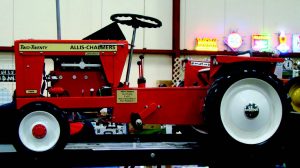

Photos 3 and 4 show a couple of pages that I found on the internet. They appear to be from an Ertl toy catalog. I realize that the print is much too small to read, but you at least can see the line-up of five unique farm toys. The resolution of the pictures was such that I could not read all of the text, even with adjusting the size and trying to focus with a magnifying glass. I could, however, rear the test within the rectangle that says “New Holland Farm Toys”. It is as follows: “Farming’s fun with New Holland toys. Built to take the ‘play power’ children can dish out, these durable, die-cast metal toys have working parts and are finished in the famous New Holland red and yellow colors. Hitches fit all Ertl toy tractors. Wonderful gifts for any youngster on any occasion!” Photo 5 shows several New Holland toys at a dealer’s table during the National Farm Toy Show in both new-in-the-box (NIB) and relatively good condition.
The first toy pictured on the Ertl catalog page is a baler. Since I could not read the print very well, I checked several sources and believe the stock number to be 751. This and all of the Ertl New Holland toys are relatively simple in construction with die-cast aluminum, stamped steel and plastic parts. The wheels and tires are plastic on all of the toys. Other items like the flywheel and pickup teeth on the baler, the drive pulleys on the combine and windrower, and the beaters on the manure spreader and forage wagon, are also plastic. In all cases, the amount of detail is relatively small, but these toys look the part and are extremely durable. In Photo 5, there is a NIB example of a baler near the top of the picture and another baler out of the box in the center. Photo 6 provides a front view of one of these balers in very nice condition as another example.
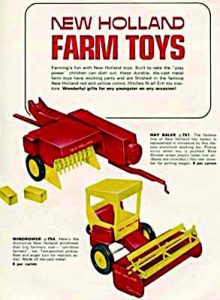
The next toy on the catalog page is the “windrower.” I have had one of these since I was a kid and we always called it a “haybine.” Some collectors refer to it as a swather as well. Regardless, it carries Ertl stock number 754 and Photo 7 provides a picture of the one I own. This one is in fairly nice shape, considering the fact that it is over 50 years old and has covered quite a bit of acreage on the basement floor. The paint on the gathering reel is coming off in spots, which seems to be a bit of an issue with these toys. A NIB example is shown in Photo 8. Note the price tag of $445! Again, more on prices near the end of this article.
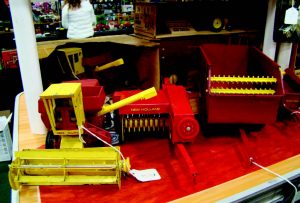
Up next is the self-propelled combine with Ertl stock number 750. I took a picture of a very nice example of one of these toys in the National Farm Toy Museum (Photo 9). The head on the combine is identical to that on the windrower, except for the paint. Note that in the catalog, the main portion of the grain head is actually shown red. I have seen this in another place, but all of the production toys seem to have a yellow grain head. That is actually correct so the catalog photo is likely of a prototype toy. The head can be raised and lowered for transport and working conditions, just as on the windrower. Tiny stamped detents hold the head in one spot or the other.
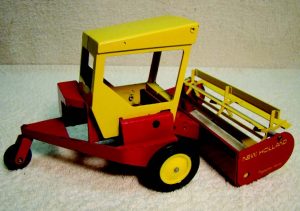
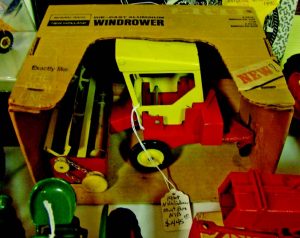
A tandem axle manure spreader was available as stock number 752. Photo 10 shows a NIB example with a price tag of $350. I received one of these as a Christmas gift in the late 1960s, but have not had the carton for years (Photo 11). This toy is really simple in that the entire bed and hitch is a single die-cast piece. The supports for the rear axle are part of the casting while the supports for the front axle are part of a stamped sheet metal piece that is riveted to the bottom of the spreader box. The “hook” at the front of the hitch is also riveted in place. Pulling the spreader turns a pulley mounted just inside of the left rear wheel. A chain attached to that turns a similar pulley attached to the beater, which makes it rotate. Unfortunately, due to the shape of the chain, the mechanism does not work as well as you might think. Loading the spreader with dirt or sand probably helps.
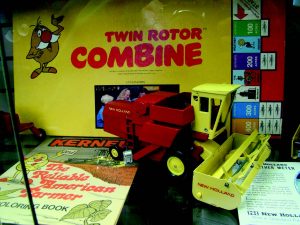
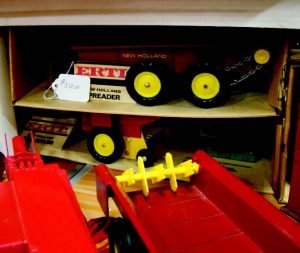
The final item is the forage wagon with Ertl stock number 753. While this has a die-cast metal “bed,” the front, sides and rear of the box are formed sheet metal. The beaters rotate, but you have to turn them by hand. The end gate slides up and swings open to empty the wagon from the rear. Photo 12 shows a NIB example of this toy that I found on the internet. This picture also provides a good overall perspective of the New Holland toy boxes. Each is a somewhat unusual “gold” color with black, white and red lettering and graphics. Also note how the pictures on the rear and end panels actually show and describe the features of the toy.
To have a complete set of all five toys NIB would be really cool, but the amount of cash it would take is significant. The forage wagon ranges from about $190 for a toy in excellent condition to around $425 NIB. I actually saw a dealer with one that had an $800 price tag on it and someone purchased it for that price! The balers range from $140 for an excellent example to about $325 NIB. Similarly, the prices for the windrower range from $200 to $450, for the combine $180 to $375 and for the manure spreader $110 to $325. Obviously, the carton is a huge factor in the price of these toys. On the other hand, being able to find really nice examples in which the toy and the carton are in excellent condition is somewhat hard to do.
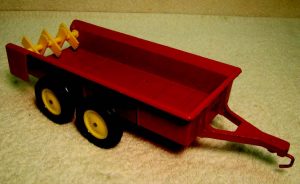
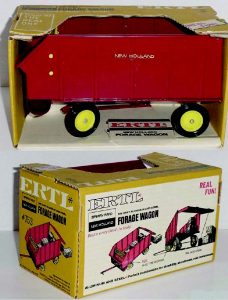
I should also mention that dealers had a couple of ways to purchase these items from Ertl. According to the most recent book by Joe Ertl entitled “Ertl Company History,” dealers could order stock number 757, which included three each of the five New Holland toys. They could also order stock number 755, which had a dozen of each of the toys and a fold-out dealer display in which all five could be shown on a counter or table. It had a backdrop and an angled display surface, all of which was made of corrugated cardboard. I have never actually seen one of these for sale, but to own one would be especially neat for a New Holland collector.
As I have mentioned in the past, many of the Ertl farm toys from the 1950s, 1960s and 1970s are some of the best examples of high quality miniatures you can find. They are simple, rugged, durable and really represent the actual machines well. Whether it is of interest or not, they also hold their value and seem to actually go up in price over time. Since I have the windrower and manure spreader, I hope to find some nice examples of the baler, forage wagon and combine— perhaps even NIB if the price is reasonable. Enjoy.


